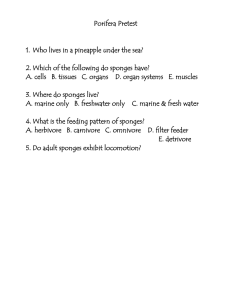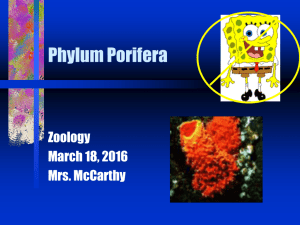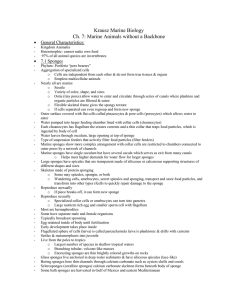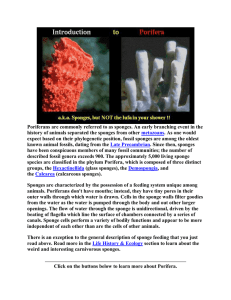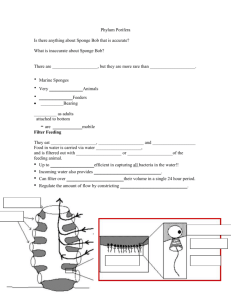Precambrian Sponges with Cellular Structures Chia-Wei Li,* Jun-Yuan Chen,* Tzu-En Hua
advertisement
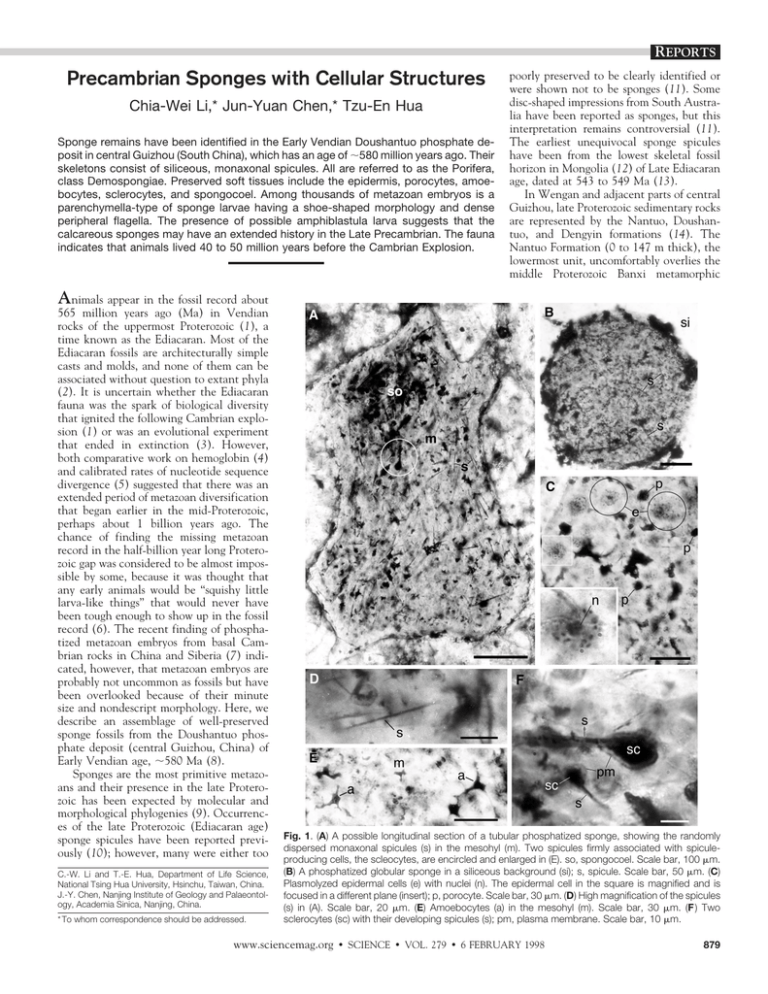
REPORTS Precambrian Sponges with Cellular Structures Chia-Wei Li,* Jun-Yuan Chen,* Tzu-En Hua Sponge remains have been identified in the Early Vendian Doushantuo phosphate deposit in central Guizhou (South China), which has an age of ;580 million years ago. Their skeletons consist of siliceous, monaxonal spicules. All are referred to as the Porifera, class Demospongiae. Preserved soft tissues include the epidermis, porocytes, amoebocytes, sclerocytes, and spongocoel. Among thousands of metazoan embryos is a parenchymella-type of sponge larvae having a shoe-shaped morphology and dense peripheral flagella. The presence of possible amphiblastula larva suggests that the calcareous sponges may have an extended history in the Late Precambrian. The fauna indicates that animals lived 40 to 50 million years before the Cambrian Explosion. poorly preserved to be clearly identified or were shown not to be sponges (11). Some disc-shaped impressions from South Australia have been reported as sponges, but this interpretation remains controversial (11). The earliest unequivocal sponge spicules have been from the lowest skeletal fossil horizon in Mongolia (12) of Late Ediacaran age, dated at 543 to 549 Ma (13). In Wengan and adjacent parts of central Guizhou, late Proterozoic sedimentary rocks are represented by the Nantuo, Doushantuo, and Dengyin formations (14). The Nantuo Formation (0 to 147 m thick), the lowermost unit, uncomfortably overlies the middle Proterozoic Banxi metamorphic Animals appear in the fossil record about 565 million years ago (Ma) in Vendian rocks of the uppermost Proterozoic (1), a time known as the Ediacaran. Most of the Ediacaran fossils are architecturally simple casts and molds, and none of them can be associated without question to extant phyla (2). It is uncertain whether the Ediacaran fauna was the spark of biological diversity that ignited the following Cambrian explosion (1) or was an evolutional experiment that ended in extinction (3). However, both comparative work on hemoglobin (4) and calibrated rates of nucleotide sequence divergence (5) suggested that there was an extended period of metazoan diversification that began earlier in the mid-Proterozoic, perhaps about 1 billion years ago. The chance of finding the missing metazoan record in the half-billion year long Proterozoic gap was considered to be almost impossible by some, because it was thought that any early animals would be “squishy little larva-like things” that would never have been tough enough to show up in the fossil record (6). The recent finding of phosphatized metazoan embryos from basal Cambrian rocks in China and Siberia (7) indicated, however, that metazoan embryos are probably not uncommon as fossils but have been overlooked because of their minute size and nondescript morphology. Here, we describe an assemblage of well-preserved sponge fossils from the Doushantuo phosphate deposit (central Guizhou, China) of Early Vendian age, ;580 Ma (8). Sponges are the most primitive metazoans and their presence in the late Proterozoic has been expected by molecular and morphological phylogenies (9). Occurrences of the late Proterozoic (Ediacaran age) sponge spicules have been reported previously (10); however, many were either too C.-W. Li and T.-E. Hua, Department of Life Science, National Tsing Hua University, Hsinchu, Taiwan, China. J.-Y. Chen, Nanjing Institute of Geology and Palaeontology, Academia Sinica, Nanjing, China. * To whom correspondence should be addressed. Fig. 1. (A) A possible longitudinal section of a tubular phosphatized sponge, showing the randomly dispersed monaxonal spicules (s) in the mesohyl (m). Two spicules firmly associated with spiculeproducing cells, the scleocytes, are encircled and enlarged in (E). so, spongocoel. Scale bar, 100 mm. (B) A phosphatized globular sponge in a siliceous background (si); s, spicule. Scale bar, 50 mm. (C) Plasmolyzed epidermal cells (e) with nuclei (n). The epidermal cell in the square is magnified and is focused in a different plane (insert); p, porocyte. Scale bar, 30 mm. (D) High magnification of the spicules (s) in (A). Scale bar, 20 mm. (E) Amoebocytes (a) in the mesohyl (m). Scale bar, 30 mm. (F ) Two sclerocytes (sc) with their developing spicules (s); pm, plasma membrane. Scale bar, 10 mm. www.sciencemag.org z SCIENCE z VOL. 279 z 6 FEBRUARY 1998 879 Fig. 2. (A) Spongocoel (so) with undigested debris. m, mesohyl; s, spicule. Scale bar, 50 mm. (B–D) Embryos with uncertain affinities. (B) A young morula, showing spherical blastomeres (two of them are framed) with yolk granules (y). Scale bar, 50 mm. (C and D) Embryos at the blastula stage. Scale bar, 50 mm. (E) A probable longitudinal section of a parenchymella larva (pa) with distinct peripheral flagella (f ). Flagella in the frame is magnified (insert). Scale bar, 50 mm. (F ) A broken specimen which might represent half of an amphiblastula larva (aa); e, epithelial cell. Scale bar, 50 mm. (G) A bud (b) is connected to its parent (p) by a curved stalk (st); s, spicule. Scale bar, 50 mm. 880 SCIENCE complex and is composed principally of tillite. The Nantuo Formation is dated from ;620 to 590 Ma. The overlying Doushantuo Formation is of early Vendian age, ;590 Ma at its base to ;565 Ma at its top. It is represented by a phosphate-dolostone sequence in Wengan, where it is 33 to 55 m thick and consists mainly of dark phosphate, cherty phosphate, chert, and gray dolomite. The Dengying Formation, containing the uppermost rocks of the Neoproterozoic, is a 180-m-thick dolomite sequence. It is Ediacaran in age, ranging from ;565 Ma at its base and 544 Ma at its top. The dark phosphate bed of Wengan contains a well-preserved, diverse flora assemblage including multicellular thallophytes, acritarchs, and cyanophytes (15). The associated fauna assemblage, however, had not been recognized. The abundant globular metazoan embryos had been previously interpreted as phytoplanktonic organisms (16). About 15 km west of the county town of Wengan on Beidaoshan, the Doushantuo Formation consists of three units: the Lower Phosphate unit (20 m thick), the Middle Dolostone unit (3.7 m) and the Upper phosphate unit (15 m). We prepared thin sections (30 mm thick) from three rock samples of a dark phosphate bed at the top of Lower Phosphate unit. We identified 35 individual sponges with light microscopy from a 160-cm2 area of the slides. These sponges are mostly globular but a few are tubular (Fig. 1, A and B), and range in size from 150 to 750 mm. The skeletons consist exclusively of thin monaxonal spicules that are randomly dispersed in the mesohyl (Fig. 1, A, B, D, and F). The spicules survived chemical treatment by 4N HCl (on two specimens for 20 min), indicating that they are siliceous (17). Most of the spicules are 0.5 to 1.0 mm in diameter and 10 to 60 mm long. The largest is 4 mm in diameter and 100 mm long. Analysis of the rocks and preservation of the Wengan fossils suggests that the sponges were buried alive by catastrophic sediment incursions. Phosphate alternation preserved the morphological details of the soft tissues. Characteristic structures of living sponges, including the epidermis, porocytes, amoebocytes, sclerocytes, and spongocoel, can be seen in the Doushantuo sponges. Many of the flat polygonal epidermal cells have their cytoplasmic contents and nuclei preserved (Fig. 1C). Dense granules surrounding the nucleus are probably cytoplasmic organelles. Scattered among the epidermal cells are porocytes that form incurrent pores (Fig. 1C). In the mesohyl, amoebocytes with a variety of shapes were seen (Fig. 1E). In one of the best preserved specimens, six spicules were closely associated z VOL. 279 z 6 FEBRUARY 1998 z www.sciencemag.org REPORTS with sclerocytes (Fig. 1F). The plasma membrane of the sclerocyte is still attached to one end of the spicule (Fig. 1F). The darkly stained spongocoel has many amorphous inclusions, representing undigested debris (Figs. 1A and 2A). We cannot interpret the nucleus of the epidermal cell and the plasma membrane of the sclerocyte conclusively, because it is known that degradation of cellular material may form structures that appear like nuclei or plasma membrane when the cell contents collapse (18). We propose that the Doushantuo sponges are monaxonid Demospongiae because their skeleton consists exclusively of siliceous and monaxonal spicules. However, it is generally interpreted that Hexactinellida evolved before both Calcarea and Demospongiae (19), and the recently discovered Ediacarian sponges from Mongolia are also referred to Hexactinellida (12). The Wengan sponge remains of Doushantuo age (Early Vendian), therefore may require revision of phylogenetic relations among the four major classes of phylum Porifera. Sponges are a monophyletic metazoan group and comprise the sister groups demosponges, hexactinellids, archaeocyaths, and calcareous sponges. Our data imply that the ancestral form in sponges lies among the demosponges. Sponges are a major component in Lower Cambrian Chengjiang fauna, where they are second only to arthropods in both generic and specific diversity (20). About 1000 sponge body fossils, distributed among 15 genera and 30 species, have been collected there. The skeletons in most species are represented exclusively by diactins, which form a regular, reticulate skeletal framework. The dermal reticulate organization of spicules is common in the Chengjiang fauna, and these fossils are classified as demosponges (21). The data from Chengjiang fauna demonstrate that main clade of early sponges, the monaxonid Demospongiae was diverse in the Lower Cambrian. We thus suggest that diactins evolved before other types of spicules. The keratosal demosponges that have skeletons composed entirely of spongin fibers, are seen first in the Lower Cambrian in Chengjiang fauna (22). Analysis of the associated rocks suggests that in the Late Proterozoic, silica biomineralization in the sponges happened in an eutrophic environment. Calcareous biomineralization in sponges (for example, archaeocyathids) is first seen in the Tommotian (;530 Ma), postdating the silica biomineralization by more then 50 million years. Calcareous biomineralization is mainly seen in oligotrophic settings. Archaeocyathids, which are possible representatives of coralline sponges (23), have a secondary calcareous skeleton of high Mg-calcite and are possibly derived from demosponges. In modern marine environments, embryos of sponges are scarce in plankton samples. One reason is that most species of sponges are viviparous, that is, their oocytes are fertilized and developed in the mesohyl (24). The other species are oviparous, releasing their gametes or zygotes into the sea (25). Thousands of embryos are evident in the thin slides of Doushantuo phosphate, but none are embedded in recognizable sponge tissue. It is thus likely either that oocytes in the mesohyl are not preserved, or that Doushantuo sponges are oviparous. The associated embryos vary in size and morphology, and many different metazoan taxa other than sponges are expected. The embryology of living sponges shows variations in different classes, and major differences chiefly revolve around the manner of formation of the three types of larvae—the amphiblastula (mainly calcareous sponges), coeloblastula (representing a heterogeneous assemblage of groups), and parenchymella (Demospongiae) (26). In some well-preserved embryos undergoing holoblastic cleavage, individual blastomeres loaded with yolk granules are evident (Fig. 2B). The most abundant fossilized embryos are at the blastula stage (Fig. 2, C and D). In sponges, the larva develops directly from the blastula, and gastrulation usually occurs at settlement (26). Three specimens could be identified as parenchymella larvae. Although their cellular structures have been disintegrated, the shoe-shaped morphology and dense peripheral flagella warrant this identification (Fig. 2E). Preservation of flagella to such a detail is rare. The diameter of the fossilized flagella is about 0.5 mm, twice as thick as that of living eukaryotic cells. This difference could be a result of diage- netic cementation. Additionally, a possible amphiblastula larva is represented by a broken specimen (Fig. 2F) that has a layer of rectangular epithelial cells and a cluster of irregularly shaped cells in the center, representing the anterior hemisphere and posterior hemisphere of the amphiblastula larvae respectively. No flagellum was found in the peripheral cell. Discovery of a possible amphiblastula larva from Doushantuo age poses a problem for the evolutionary phylogeny among phylum Porifera. The calcareous sponges and accompanying calcareous biomineralization may have a long, unknown Precambrian history. Additional material is needed to confirm this interpretation. These two types of sponge larvae have been recorded earlier from the same site, but they were recognized as acritarchs (18). Methods of asexual reproduction, including reduction, gemmulation, and budding, occur naturally in sponges (26). In budding, cells migrate to the tip of a thin stalk and form a definite bud which then drops off and becomes free. This method of reproduction is relatively uncommon (26). We found two nearly spherical sponges connected by a curved thin stalk (Fig. 2G). This observation may suggest the occurrence of bud formation. The parent is distinctly spiculate, and few minute spicules are present in the bud (Fig. 2G). Symbiosis between shallow-water sponges and photosynthetic organisms is common in tropical and subtropical seas. About half of the sponge species in the Caribbean contain symbiotic cyanobacteria or other algae, and the average symbiont concentration in the species is 10% (27). The Wengan sponges are intermingled with a variety of thallophytic seaweeds, and thus should have inhabited a shallow sea. Cellular structures of these seaweeds are usually wellpreserved. In several cases, even the nuclei and chloroplasts can be distinguished (Fig. Fig. 3. (A) A thallophytic seaweed consists of a single layer of cells. Scale bar, 50 mm. (B) High magnification of the cells in (A), showing the nucleus (n) and chloroplast (c). Scale bar, 10 mm. www.sciencemag.org z SCIENCE z VOL. 279 z 6 FEBRUARY 1998 881 3). As no recognizable algal cells are present in the mesohyl, a symbiotic relation with photosynthetic organisms may not have been established in the Wengan sponge fauna. The occurrence of soft-tissue preservation and of cellular structures in the Wengan fauna indicates that animals lived 40 to 50 million years before the Cambrian explosion. The phosphate deposits that encase this minute, soft-bodied, and oldest fauna crop out over an area of about 57 km2 in central Guizhou. These rocks provide a potentially inexhaustible resource for understanding the early evolution of animal life. REFERENCES AND NOTES ___________________________ 1. M. A. Glaessnner, The Dawn of Animal Life: A Biohistorical Study (Cambridge Univ. Press, Cambridge, 1984); A. P. Benus, in Trace Fossil, Small Shelly Fossils and the Precambrian-Cambrian Boundary, E. Landing, G. M. Narbonne, P. Myrow, Eds. (Bull. 463, New York State Museum, Albany, 1988 ), p. 8.; G. J. Vermeij, Science 274, 525 (1996). 2. B. Runnegar, Neues Jahrb. Geol. Palaeontol. Abh. 195, 305 (1995); A. H. Knoll, Paleobiology 22, 1 (1996); M. A. Fedonkin and B. M. Waggoner, Nature 388, 868 (1997 ). 3. A. Seilacher, Lethaia 22, 229 (1989); G. J. Retatake, Paleobiology 20, 523 (1994); A. Seilacher, in Pattern of Change in Earth Evolution, H. D. Holland and A. F. Tendall, Eds. (Springer, Berlin, 1984); S. J. Gould, Sci. Am. 271, 84 (October 1994); S. Conway Morris, Palaeontology 36, 593 (1993); J. P. Grotzinger, S. A. Bowring, B. Z. Saylor, A. J. Kaufman, Science 270, 598 (1995). 4. B. Runnegar, Lethaia 15, 199 (1982). 5. G. A. Wray, J. S. Levinton, L. H. Shapiro, Science 882 SCIENCE 274, 568 (1996). 6. E. H. Davidson, K. J. Peterson, R. A. Cameron, ibid. 270, 1319 (1995). 7. S. Bengtson and Y. Zhao, ibid. 277, 1645 (1997 ); X. Zhang and B. R. Pratt, ibid. 266, 637 (1994). 8. A. H. Knoll, J. P. Grotzinger, A. J. Kaufman, P. Kolosov, Precamb. Res. 73, 251 (1995). 9. P. O. Hinkle, G. Hinkle, M. L. Sogin, S. K. Stickle, Science 260, 340 (1993); S. Conway Morris, in Early Life on Earth, S. Bengtson, Ed. (Columbia Univ. Press, New York, 1994), pp. 450 – 459; J. M. Moldowan, J. Dahl, S. R. Jacobson, B. J. Huizinga, M. A. McCaffrey, R. E. Summons, Terra Nova 6, 6 (1994); W. E. G. Muller, H. C. Schroder, I. M. Muller, V. Gamulin, J. Mol. Evol. 39, 369 (1994). 10. T.-F. Tang and X.-J. Jiang, Acta Stratigraph. Sinica (in Chinese) 2, 32 (1978); M. Steiner, D. Mehl, J. Reitner, B.D. Erdtman, Berliner Geowiss. Anh. Ser. E 9, 293 (1993). 11. J. G. Gehling and J. K. Rigby, J. Palaeontol. 70, 185 (1996). 12. M. Brasier, O. Green, G. Shields, Geology 25, 303 (1997 ). 13. J. P. Grotzinger, S. A. Bowring, B. Z. Saylor, A. J. Kaufman, Science 270, 598 (1995). 14. Y.-G. Wang, Y.-L. Chen, R. -G. Wang, X.-W. Chen, S.-S. Wei, in Sinian System of China ( Tianjin Scientific Press, Tianjin, 1980), pp. 147–163. 15. M. G. Chen and K. W. Liu, Geol. Sinia 1, 46 (1986); Y. Zhang, Lethaia 25, 113 (1989); L.-M. Yin and Z.-P. Li, Bull. Nanjing Inst. Geol. Paleontol. 10, 41 (1978); C.-F. Ying, Acta Micropalaeontol. Sinica 7, 265 (1990); Y. Zhang and X.-L. Yuan, Lethaia 25, 1 (1992); X.-L. Yuan, Q.-F. Wang, Y. Zhang, Acta Micropalaeontol. Sinica 10, 409 (1993). 16. L.-M. Yin and Y.-S. Xue, Chinese J. Botany 5,168 (1993); Y.-S. Xue, T.-F. Tang, C.-L. Yu, C.-M. Zhou, Acta Palaeontol. Sinica 36, 688 (1995). 17. Ten milliliters of 4N HCl were put on each of the phosphatized sponges, which are encapsulated in silicate. After 20 min, the viscous solution containing dissolved phosphate were carefully removed, and the specimens were gently rinsed with distilled H2O. All the spicules survived the chemical treatment and were embedded in the collapsed organic matrix. 18. 19. 20. 21. 22. 23. 24. 25. 26. 27. 28. Seven spicules were removed and were studied with a scanning electron microscope; however, no additional morphological characteristics were seen. S. Francis, L. Margulis, E. S. Barghoorn, Precambr. Res. 6, 65 (1978). J. Reitner and D. Mehl, Geol. Paluonl. Mill. Innsbruck, ISSN 0378-6870 20, 335 (1995); R. Wood, Zhuravlev, A. Yu, F. Debrenne, Palaios 7, 131 (1992). J.-Y. Chen and D. B. Erdtmann, in The Early Evolution of Metazoan and the Significance of Problematic Taxa, A. M. Simontta and S. Conway Morris, Eds. (Cambridge Univ. Press, Cambridge, 1991), pp. 57– 76; J.-Y. Chen, G.-Q. Zhou, M.-Y. Zhu, K.-Y. Yeh, in The Chengjiang Biota—A Unique Window of the Cambrian Explosion (National Museum of Natural Science, Taichung, Taiwan,China, 1996). J.-Y. Chen, X.-G. Hou, H.-Z. Lu, Acta Palaeontol. Sinica 28, 17 (1989); J.-Y. Chen, X.-G. Hou, G.-X. Li, ibid. 29, 402 (1990). A single specimen has been observed by J.-Y. Chen from Chengjiang fauna. J. Reitner, in New Perspectives in Sponge Biology, K. Rutzler, Ed. (Smithsonian Institution Press, Washington, DC, 1990), pp. 33– 42; R. Wood et al., in (19). P. E. Fell, in Reproduction of Marine Invertebrates, A. C. Giese and J. S. Pearse, Eds. (Academic Press, New York, 1974), vol. I, pp. 51–131. H. Reiswig, in Aspects of Sponge Biology, F. W. Harrison and R. R. Cowden, Eds. (Academic Press, New York, 1976 ), pp. 99 –112. T. L. Simpson, The Cell Biology of Sponges (Springer-Verlag, New York, 1984). K. Rutzler, in New Perspectives in Sponge Biology, K. Rutzler, Ed. (Smithsonian Institution Press, Washington, DC, 1990 ), pp. 455 – 466. We thank P.-H. Chao for technical help. Supported by the National Science Council, the Foundation of the National Museum of Natural Science (C.-W. Li and T.-E. Hua), and the National Committee of Sciences and Technology, the National Sciences Foundation of China, the National Geographic Society (grant no. 5670-96) (J.-Y. Chen). 10 December 1997; accepted 23 January 1998 z VOL. 279 z 6 FEBRUARY 1998 z www.sciencemag.org

